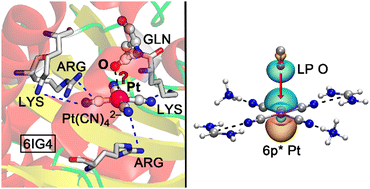Enzymatic reversion of Pt(ii) nucleophilicity through charge dumping: the case of Pt(CN)42−†
Abstract
Combining computations and X-ray structure analysis we have demonstrated that [Pt(CN4)]2− can behave as a Lewis acid inside an enzyme's cavity. The nature of a counterintuitive contact found between a catalytically active GLN residue belonging to a mitochondrial synthase and the Pt(II) center was investigated by combining molecular dynamics and quantum mechanics calculations. Results confirm the electron acceptor role of [Pt(CN4)]2−, serving as an inspiration for the design of biomolecular cages able to tweak the nucleophilic/electrophilic character of an organometallic compound.



 Please wait while we load your content...
Please wait while we load your content...